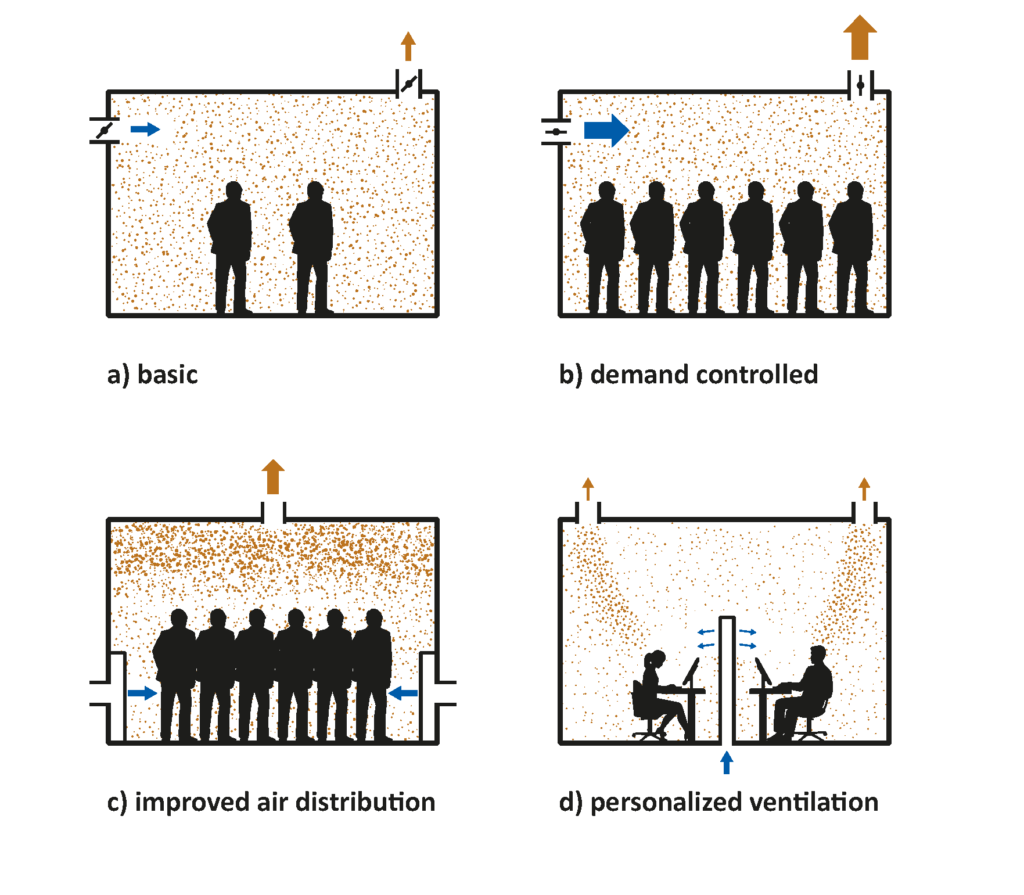14.5.2021
A significant article on IAQ policy was published in the Journal Science (* on May 13th written by 40 scientists from 14 counties, of which the five undersigned are from Nordic countries. The group was led by Prof. Lidia Morawska from Queensland Technical University. The main message of the article is that focus on building regulations, and guidelines should be changed from comfort to health of occupants, as the subtitle of the article states, “Building ventilation systems must get much better.”
The background of the paper is that while individuals can be infected in close proximity, community outbreaks of infections occur at larger distances. Such airborne transmission is potentially the dominant mode of transmission for numerous respiratory infections, and not only the Covid-19 disease. Consequently, the current pandemic has initiated the discussion among scientists on how the building can be made safer and healthier for occupants.
Before Covid-19, no engineering-based measures had been applied to limit community respiratory infection transmission in public buildings (excluding hospitals). This happened even though the existing evidence suggests that controlling airborne infections will cost society less than to bear it and even though some engineering solutions have already been developed to support this change.
The benefits of improved conditions of indoor air quality in buildings extend beyond reducing the risk of infectious disease transmission and include improved general health, well-being, productivity, and learning, as documented in many studies. However, as the cost for the improved indoor air quality and building investment are paid from different pockets, the good cost-benefit ratio is often ignored.
WHO provides air quality guidelines for permissible levels of some chemicals in the air. There are, however, no ventilation guidelines set specifically to control these pollutants indoors. None of the international guidelines provide recommendations for mitigating bacteria or viruses in indoor air originating from human respiratory activities. To this end, WHO has only recently published the ventilation road map to deal with the COVID-19 crisis. At the moment, airborne infection control exists only in health care facilities, where the requirements for ventilation rates are typically significantly higher than in other public buildings.
The challenge is that the ventilation rates required to protect against infection transmission cannot be derived in the same way as for other pollutants. In the case of infection control, the ventilation rates must be risk-based rather than absolute. They have to be developed based on the assessment of infection risk.
Future ventilation systems should follow well known principles: they must be demand controlled, flexible and depend on the purpose and activity taking place (occupant density, physical activity, use of voice, etc.). Most importantly they should deliver clean air to breathing zone and remove the polluted air immediately before it is mixed completely within a space volume. Some solutions following this principles have been developed but they are seldom applied in the practical applications.

Critical is also the change in the operation of a building. Protective measures, even well known, cannot be easily implemented during the current pandemic because the present building systems have not been designed for limiting respiratory infections, and building owners and operators were not trained to operate the systems during a pandemic.
The principles outlined above will not only control the risk but also address other requirements, including control of pollutants from indoor and outdoor sources and the need for low energy use.
As a path forward, the article presents that:
- WHO air quality guidelines must be extended to include airborne pathogens. The guidelines must recognize the need to control the hazards of airborne transmission of respiratory infections. A good step in this direction is the ventilation road map published recently by WHO but more actions are needed.
- Professional engineering bodies must develop comprehensive ventilation standards that include control of respiratory infection.
- Current standards must be improved to explicitly consider infection control in their statements of purposes and definitions.
- New solutions and incentives must be developed to encourage implementing these standards, e.g., ventilation certificates similar to those for food hygiene certification for restaurants.
- Wide use of monitors displaying the state of IAQ must be mandated. At present, the public is not well aware of the significance of IAQ. Sensor technologies exist to display numerous parameters characterizing IAQ. Visible displays will help keep building operators accountable for ensuring good IAQ and will advance the public´s awareness.
The proposed paradigm shift must occur now and be on a scale comparable with 19th century Britain when the government encouraged cities to organize clean water supplies and centralized sewage systems. In the 21st century, we need to establish the foundations to ensure that the air in our buildings is clean and pathogen-free, contributing to the building occupants’ health just as we expect for the water coming out of our taps will be pollution and infection-free.
We, the co-authors of the article, call the Nordic governments and professional organizations to support this necessary paradigm shift and lead its development.
Jarek Kurnitski, Professor, TalTech – Tallinn University of Technology; [email protected] (+372 58664370)
Arsen Melikov, Professor, DTU – Technical University of Denmark; [email protected] (+45 61715626)
Peter V. Nielsen, Professor emeritus, Aalborg University; [email protected] (+45 5160 0460)
Olli Seppänen, Professor emeritus, Aalto University; [email protected] (+358 405741873)
Pawel Wargocki, Associate Professor, DTU – Technical University of Denmark; [email protected] (+45 45254011)
*) Science is a peer-reviewed academic journal of the American Association for the Advancement of Science (AAAS). It is one of the world’s top academic journals. It was first published in 1880. Its impact factor is over 40, and is estimated to reach half a million readers.